Making Space
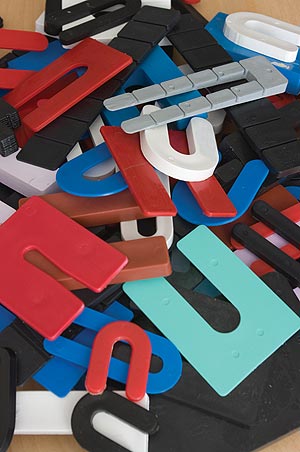 Shims are ubiquitous. Their only role is to hold space in a joint, and the designer generally gives the joint far more attention.
Shims are ubiquitous. Their only role is to hold space in a joint, and the designer generally gives the joint far more attention.
Do-it-yourself projects may include scraps of wood, wood wedges, shingles, or even strips of aluminum cut from a soda can, all fulfilling the role of the shim. However, the professional contractor and the design professional need a higher class of shim that can play its role in reliable, engineered systems.
Structural plastic shims give the project team consistent performance in an array of circumstances. Like sealants, adhesives, and grout, shims are common accessories in systems throughout construction projects. Design professionals may dismiss shims as ‘means and methods’—the contractor’s responsibility. However, under many conditions, shims are important to the success of a system and the project. For instance, a shim that becomes a permanent part of construction needs to be just as fire-, mold-, and insect-resistant as the surrounding materials in order to avoid being the system’s weak point. Shims in glazing systems must both accommodate and resist the movement of those systems, preventing glass-to-glass or glass-to-metal contact, but yielding to pressure, thus reducing glass breakage. Though their footprints are small, shims can make big differences in the outcomes of construction projects.
Depending upon how a project is specified and delivered, the design professional may legitimately leave most aspects of shim selection to the contractor’s suppliers and installers. If a system's overall performance is adequately specified, and if the contractor's responsibility for that performance is clear, the shim's contribution to system performance is also the contractor's responsibility. Controlling the selection of shims is most important when the design team is already controlling the other materials in a system very tightly.
For instance, if a fragile stone is chosen for a wall cladding, the contractor may have little to no control over the stone's performance. In this case, the success of the system depends on the design team's ability to correctly detail the support of the stone, including the resilience of permanent and temporary shims. Other installations may require fire-resistant or rot-resistant shims, criteria that may not be obvious to the contractor. It is in these specialty conditions when the design professional most needs to know how shims are selected and used.
Selection Criteria
Understanding the role of the shim in the system it serves allows the design professional to choose shims that best serve the system. Temporary shims need to meet basic requirements for size, strength, and ease of use. Permanent shims are subject to more extensive requirements to ensure the continued performance of the materials they support and separate.
Material
Traditionally, shims have been made of wood and metal because these materials are easily shaped and often found as scrap on jobsites. Wood is often used in wood-framed construction and cabinetry, but it is subject to crushing and rot. Steel is the material of choice in much structural steel work, but can cause rust damage in other systems where moisture may run across it.
Purpose-made structural plastic shims have made a place for themselves in today’s faster-paced construction. Requiring little or no shaping, and available in consistent thicknesses and material properties, plastic structural shims save labor time. Since plastic can be made stronger than wood, more dimensionally stable than steel, and resistant to moisture and microbes, it is the material of choice for many building systems.
Size
The most important properties of shims are their ability to separate and adjust the spacing between items in construction. The shim’s thickness is chosen according to the depth of the space it is intended to maintain. The footprint is chosen according to handling and load distribution needs. A permanent shim should be sized to fit entirely within the joint, behind the finish materials, and without interfering with any sealant that can be installed in the joint.
Shape
Flat blocks are used for simple conditions where spaces will be later filled with grout or sealant, such as joints in tilt-up concrete panel and unit masonry construction (they are best for bringing together two surfaces where the joint size is known).
U-shapes, on the other hand, fit around bolts and are useful for many systems of construction, including precast concrete cladding and curtain wall systems (they usually form permanent spacers). A third shape, the wedge, can be inserted between two objects already in place to adjust the size of a joint. They are often used to temporarily hold objects in place until they are anchored.
Compressive Strength
One should choose a product with compressive strength that can withstand the expected dead, construction, and live loads the shim will carry. Shims support large loads over their small footprints during construction, before the final fastening is complete, so including a safety factor is a good idea. Figure 1, below, shows ranges of compressive strengths available with different structural plastic shim materials.
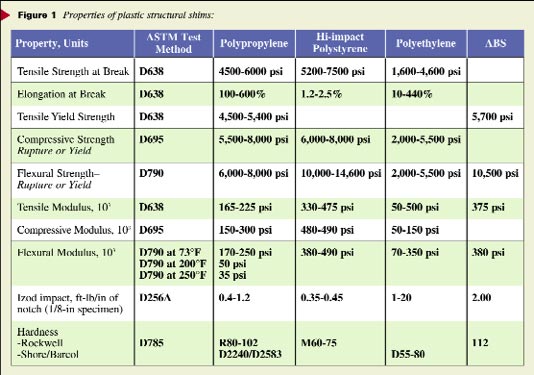
Creep
Shims with compressive strength adequate to the task at hand will not deform under the expected loads. By contrast, materials like wood suffer from ‘creep’ (i.e. deformation over time), forcing installers to guess at the final compressed thickness when selecting shims. Choosing structural shims takes the guesswork out of installation. It is worth noting that creep can be a problem with high-density polyethylene (HDPE) used as permanent support.
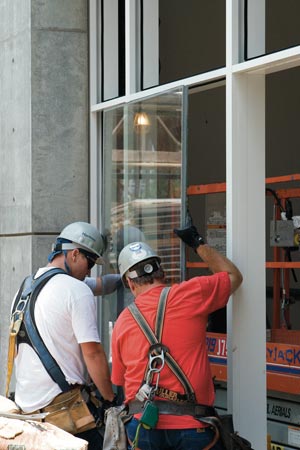 Resilience
Resilience
Resilience is the ability of a shim to compress under load and then return to its previous shape when the load is released. It is expressed in ASTM E18, Standard Test Methods for Rockwell Hardness of Metallic Materials, and ASTM D2240, Standard Test Method for Rubber Property–Durometer Hardness.
Resilience is often required in glazing systems and other panelized cladding systems. When materials being separated are brittle—like glass or stone—the shim’s job is to absorb some of the load imposed by system movement. One should consult the Glass Association of North America’s (GANA’s) standards for glazing systems; stone fabrication guides such as the Indiana Limestone Handbook offered by the Indiana Limestone Institute of America may also suggest requirements. For other brittle materials such as terra cotta, the manufacturer or supplier may make recommendations for the resilience of shims.
Impact Resistance
Impact resistance is the shim’s ability to withstand a sudden force, usually over a small area, without breaking or crushing. Impact resistance is often required for shims used to install glazing systems. When high impact resistance is required, high-impact polystyrene or polyvinyl chloride (PVC) shims are often required.
Resistance to Brittle Failure
If very cold temperatures are expected during construction or the shim’s service life, brittle failure needs to be considered. The temperature at which cracking occurs should be below the expected ambient temperature. In some conditions, the shim can be retained in the joint with adhesive, making cracking less of a concern.
Fire Safety
Shims that will remain permanently within an assembly may be required to resist the effects of fire. Where shims are permanently part of a fire-resistive assembly, it may be necessary to test the assembly’s performance. Shims exposed in unfinished spaces such as plenums and attics are subject to the same flame spread and smoke developed performance requirements as insulation and wiring.
Noncombustible construction is necessary for certain construction types and occupancies, depending on the building code in effect. Though less common, melting point and flammability may also be specified if necessary. (See Figure 2, below, for tests and performance standards that apply to the fire safety of shims.)
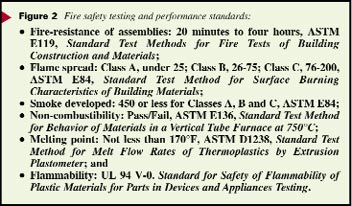
Compatibility
A compatible product does not react with or chemically affect the materials it touches. It will not transfer color or oils, produce stains, or corrode the item being shimmed. It will also be unaffected by the adjacent materials. Polypropylene and polystyrene both excel in this feature, being unaffected by most construction materials. In fact, inert plastics are often used to separate dissimilar materials that would otherwise react with each other (e.g. separating aluminum from concrete or from steel).
Vermin and Decay Resistance
Inert plastic shims can remain in place indefinitely, without contributing nutrients to unwanted organisms like mold or insects. Unlike wood and wood products, plastic structural shims do not rot or decay.
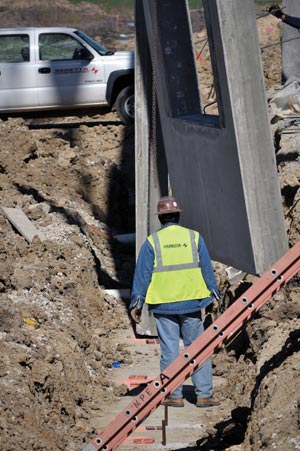
Ease of Use
Shims are easy to use for various reasons. For example, shims are frequently colored by thickness, simplifying and speeding installation and inspection in the field. Further, there is an opportunity for stackability. Stackable shims can fit virtually any size joint, from 0.8 to 152 mm (1/32 to 6 in.), by combining standard sizes. Plastic structural shims can be banded together. Some plastics also are readily heat-welded at the edges, forming a permanent stack custom-built for the joint required.
In order to fit joint requirements, shims should be available in various widths, and in shapes that are easily cut to size. Some U.S. manufacturers offer shims in 152 and 203-mm (6- and 8-in.) wedge shapes that are notched to be snapped at convenient lengths and depths. Unnotched shims can be trimmed with knives or saws.
Thermal Performance
Shims can act as a thermal break between conductive materials. Measured in Btu per hour or in Watts, the thermal conductance of plastic shims is lower than that of aluminum or steel. For example, shims can help reduce thermal transfer from cladding materials, such as precast concrete, into structural elements.
Environmental Considerations
Plastic shims are available with high recycled content (HRC). Temporary shims are often reused, but broken shims and scraps may be recycled. Since they are such a small part of most projects, they are unlikely to contribute significantly to Leadership in Energy and Environmental Design (LEED) credits for regional materials or recycled content. However, many are made in the United States to save shipping energy and costs.
Shims are typically made from materials that have little to no effect on indoor air quality, and their small size makes concerns about volatile organic compounds (VOCs) de minimus. Since they are solid, they are not governed by VOC limits that apply to liquid or elastomeric adhesives and sealants, whether in green building rating systems or in air quality regulations.
Common Uses of Shims
In general, shims are used as alignment aids to hold objects in place until they are permanently attached with fasteners, welds, grout, adhesive, or other methods. Examples of this use occur in many areas of construction. The list below is not exhaustive, but serves to demonstrate the versatility of shims.
Divisions 03 and 04
In systems with heavy panels, such as tilt-up concrete, precast concrete, or panelized masonry, shims are used to level and align the panels and maintain regular joint spacing in preparation for final attachment.
Masonry systems, especially large pieces like caps and lintels, may require shims for temporary joint spacing. Shims may be used to relieve stress while the mortar sets, or simply to maintain the position of featured pieces until the mortar placement is complete. Shims are readily available in 9.5-mm (3/8-in.) thickness, the most common joint size in brick construction.
Brittle materials like terra cotta can be temporarily cushioned with shims before being fixed or sealed into place.
Division 05
Typically, structural steel is shimmed with steel shims. However, many other metal objects are shimmed temporarily with plastic shims before welding, grouting, or bolting into place. Plastic shims can also separate dissimilar metals to protect against galvanic action, and in some cases can provide a thermal break.
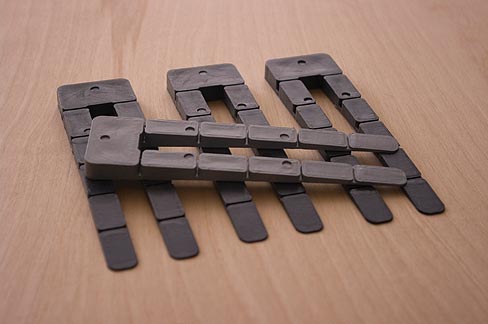 Division 06
Division 06
Heavy wood members that would crush a wood shim can be shimmed with plastic shims. Typical applications include heavy timber framing, glue-laminated (gluelam) members, and prefabricated joists or trusses.
Divisions 07 and 08
Shims may be used to align door and window frames, skylights, louvers, and metal panels or to hold standard joint widths while fastening components in place. They can also be employed to hold standard joint widths while fastening components in place.
Whether permanent or temporary, shims are often used to separate glass panels from each other or from framing until permanent gaskets or sealants are installed. Glass setting blocks and edge blocks are also specific types of shims, permanently supporting glass in framing.
Wherever sealants are used, shims are likely to have been there first. Throughout the other Master Format divisions, shims are used to maintain joint width, either permanently or temporarily, until sealants are placed and cured.
Division 09
Where joint widths in finish materials are critical for appearance and sealant performance, shims are often used to align materials and maintain regular joints. Stone flooring, interior stone cladding, wood panel ceilings, and decorative wall panels are all finishes that may need temporary shims during installation. Generally, the shims are progressively removed as final joint materials are placed.
Divisions 10 - 14 and 23
Heavy objects such as directories, signage, telephone kiosks, benches, and fixed audience seating can be aligned temporarily with shims before being permanently fixed into place. Tracks and rails for sliding partitions, elevators, and escalators can be shimmed for alignment and thus smoother equipment operation. Even large motorized equipment such as HVAC fans require careful leveling that can be aided with shims.
Specifying Shims
Shims are considered “accessories” and are appropriately specified with other parts of the “work results” or building systems in which they are used.
When specifying the shims themselves in Part 2–Products, the specifier should include information necessary to assure proper performance for project conditions. It is usually unnecessary for the specifier to require a specific shape or size of shim, but types or material properties may be important. When load bearing is important, for instance, specify that shims shall be solid, and that hollowed profiles will not be accepted. Compatibility, resilience, and fire resistance are all material properties that may be specified in Part 2.
Execution requirements for shims should also be results-oriented. Example requirements found in Part 3–Execution may include:
- “Shims shall not remain permanently exposed to view, sun, or weather;”
- “Hold shims back from face of panel at least two times joint width” for mortar or grout joints;
- “Shims shall not intrude into depth required for sealant and backer rod specified” for sealant joints;
- “Remove shims progressively as sealant is installed” for movement joints in stone flooring;
- “Install shims to shed water. Horseshoe and keyslot shim openings shall face down” for shims behind cladding, outside the weather barrier; and
- “Do not shim cladding more than [insert dimension] without written acceptance by Engineer.”
The design professional who understands the uses, pitfalls, and possibilities of shims is equipped to control key properties of the shims used in his or her projects. Selecting the proper shims can help ensure the alignment, resilience, and permanence of building systems, and thus the performance of the project as a whole.
Abstract
Like sealants, adhesives, and grout, shims are common accessories throughout construction projects. Under many conditions, they are important to the success of a system and the project. Shims in glazing systems must both accommodate and resist the movement of those systems, preventing glass-to-glass or glass-to-metal contact, but yielding to pressure, thus reducing glass breakage. Though their footprints are small, shims can make big differences in the outcomes of construction projects.
Master Format No.
08 85 00–Glazing Accessories
UniFormat No.
B2010.10 Wall Panels-Exterior Walls
B2020 Windows-Exterior
B3060.10 Skylights
Key Words
Division 08
Impact resistance
Shims
David Braune, CSI, is the president of Grove Products. He has been with the company for more than 40 years. Braune can be reached at sales@groveproductsinc.com.
Simon Braune, CSI, is the vice president of Grove Products. He can be contacted via e-mail at sbraune@groveproductsinc.com.
Vivian Volz, RA, CSI, CCS, LEED AP BD+C, is an architectural specifier in private practice in California, and a consultant to Chusid Associates. She is president of the San Francisco Chapter of the Construction Specifications Institute (CSI) and serves on the Editorial Advisory Board for The Construction Specifier. Volz can be reached via www.chusid.com.